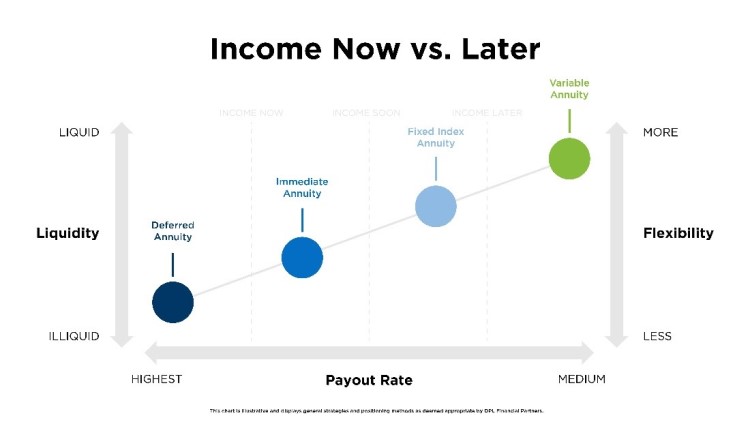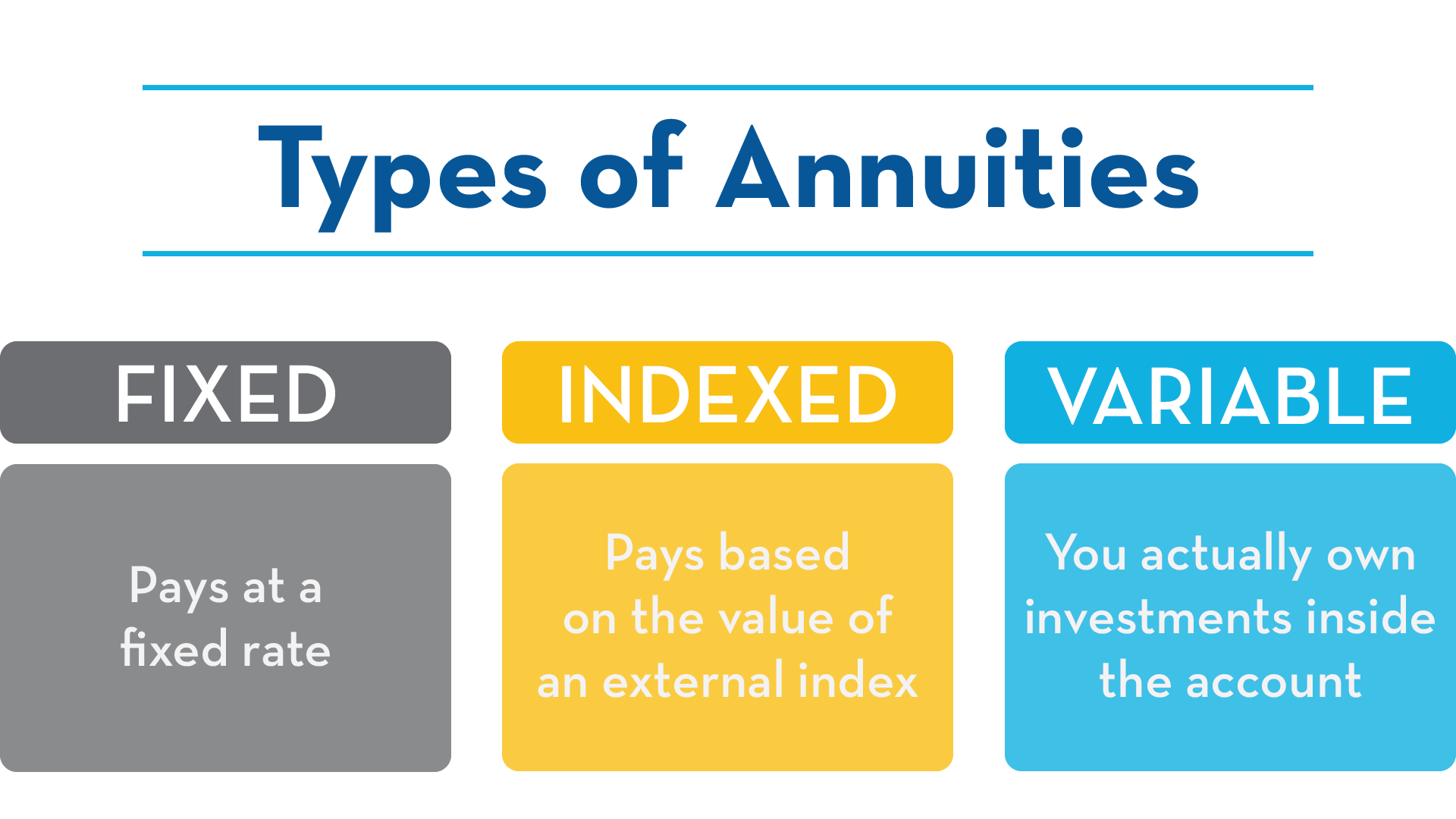Featured
Table of Contents
The payment could be invested for development for an extended period of timea solitary costs deferred annuityor invested momentarily, after which payment beginsa solitary costs prompt annuity. Single costs annuities are typically funded by rollovers or from the sale of an appreciated property. A versatile costs annuity is an annuity that is meant to be funded by a series of repayments.
Owners of repaired annuities know at the time of their acquisition what the worth of the future capital will be that are created by the annuity. Undoubtedly, the variety of capital can not be understood ahead of time (as this depends upon the contract proprietor's life expectancy), yet the assured, dealt with rate of interest price at the very least offers the proprietor some level of certainty of future revenue from the annuity.
While this difference seems simple and straightforward, it can significantly affect the value that an agreement owner eventually stems from his or her annuity, and it creates significant uncertainty for the contract owner - Investment options in variable annuities. It also generally has a product influence on the level of charges that an agreement owner pays to the issuing insurance provider
Set annuities are commonly utilized by older financiers who have restricted assets but that want to counter the threat of outliving their assets. Set annuities can offer as an efficient tool for this objective, though not without particular drawbacks. In the situation of prompt annuities, once a contract has been purchased, the agreement owner relinquishes any kind of and all control over the annuity possessions.
Analyzing Strategic Retirement Planning Key Insights on Your Financial Future What Is Fixed Index Annuity Vs Variable Annuity? Benefits of Choosing the Right Financial Plan Why Choosing the Right Financial Strategy Matters for Retirement Planning Variable Annuity Vs Fixed Annuity: Explained in Detail Key Differences Between Annuities Fixed Vs Variable Understanding the Rewards of Fixed Index Annuity Vs Variable Annuity Who Should Consider Annuity Fixed Vs Variable? Tips for Choosing Fixed Annuity Vs Equity-linked Variable Annuity FAQs About Fixed Annuity Or Variable Annuity Common Mistakes to Avoid When Choosing a Financial Strategy Financial Planning Simplified: Understanding Your Options A Beginner’s Guide to Smart Investment Decisions A Closer Look at Fixed Index Annuity Vs Variable Annuities
For instance, an agreement with a typical 10-year abandonment duration would bill a 10% abandonment cost if the agreement was given up in the initial year, a 9% surrender fee in the 2nd year, and so on till the surrender charge gets to 0% in the contract's 11th year. Some deferred annuity agreements include language that enables for little withdrawals to be made at different periods throughout the surrender duration without charge, though these allowances usually come with a price in the type of lower surefire interest rates.
Just as with a fixed annuity, the owner of a variable annuity pays an insurance provider a lump amount or series of payments for the pledge of a series of future settlements in return. As mentioned above, while a taken care of annuity grows at an assured, constant price, a variable annuity grows at a variable rate that depends upon the efficiency of the underlying investments, called sub-accounts.
Throughout the accumulation stage, assets bought variable annuity sub-accounts grow on a tax-deferred basis and are strained only when the agreement owner withdraws those earnings from the account. After the accumulation stage comes the revenue phase. Over time, variable annuity assets should theoretically enhance in worth up until the agreement proprietor chooses she or he want to start withdrawing cash from the account.
The most substantial problem that variable annuities usually present is high cost. Variable annuities have a number of layers of fees and costs that can, in aggregate, create a drag of up to 3-4% of the contract's value each year.
M&E expense costs are calculated as a percentage of the contract value Annuity providers hand down recordkeeping and various other administrative expenses to the contract owner. This can be in the type of a level yearly fee or a percent of the agreement worth. Management fees may be consisted of as part of the M&E danger charge or may be evaluated individually.
These charges can range from 0.1% for passive funds to 1.5% or even more for actively handled funds. Annuity agreements can be customized in a number of ways to offer the particular needs of the contract proprietor. Some common variable annuity riders consist of ensured minimal accumulation benefit (GMAB), ensured minimum withdrawal advantage (GMWB), and assured minimal earnings benefit (GMIB).
Analyzing Strategic Retirement Planning Key Insights on Fixed Annuity Vs Equity-linked Variable Annuity What Is Variable Annuity Vs Fixed Indexed Annuity? Pros and Cons of Various Financial Options Why Choosing the Right Financial Strategy Can Impact Your Future How to Compare Different Investment Plans: Explained in Detail Key Differences Between Different Financial Strategies Understanding the Rewards of Long-Term Investments Who Should Consider Strategic Financial Planning? Tips for Choosing the Best Investment Strategy FAQs About Planning Your Financial Future Common Mistakes to Avoid When Choosing Variable Annuity Vs Fixed Indexed Annuity Financial Planning Simplified: Understanding Your Options A Beginner’s Guide to Smart Investment Decisions A Closer Look at How to Build a Retirement Plan
Variable annuity contributions give no such tax deduction. Variable annuities have a tendency to be very inefficient automobiles for passing wealth to the next generation because they do not delight in a cost-basis modification when the original contract owner dies. When the proprietor of a taxable investment account dies, the expense bases of the investments held in the account are changed to mirror the marketplace rates of those investments at the time of the owner's fatality.
Such is not the case with variable annuities. Investments held within a variable annuity do not receive a cost-basis modification when the original owner of the annuity passes away.

One significant concern connected to variable annuities is the possibility for conflicts of passion that may exist on the component of annuity salesmen. Unlike an economic advisor, that has a fiduciary task to make financial investment choices that profit the client, an insurance coverage broker has no such fiduciary obligation. Annuity sales are extremely rewarding for the insurance experts who sell them due to the fact that of high upfront sales payments.
Lots of variable annuity contracts have language which positions a cap on the percent of gain that can be experienced by specific sub-accounts. These caps prevent the annuity proprietor from completely taking part in a section of gains that could or else be appreciated in years in which markets generate substantial returns. From an outsider's viewpoint, it would certainly appear that financiers are trading a cap on investment returns for the abovementioned assured flooring on investment returns.
Breaking Down Variable Annuity Vs Fixed Annuity Key Insights on Indexed Annuity Vs Fixed Annuity What Is Variable Annuity Vs Fixed Indexed Annuity? Pros and Cons of Various Financial Options Why Choosing the Right Financial Strategy Can Impact Your Future How to Compare Different Investment Plans: How It Works Key Differences Between Different Financial Strategies Understanding the Risks of Variable Annuity Vs Fixed Annuity Who Should Consider Fixed Indexed Annuity Vs Market-variable Annuity? Tips for Choosing Fixed Vs Variable Annuity Pros And Cons FAQs About Pros And Cons Of Fixed Annuity And Variable Annuity Common Mistakes to Avoid When Choosing a Financial Strategy Financial Planning Simplified: Understanding Your Options A Beginner’s Guide to Smart Investment Decisions A Closer Look at How to Build a Retirement Plan
As noted above, give up costs can seriously limit an annuity owner's capacity to relocate possessions out of an annuity in the early years of the contract. Even more, while the majority of variable annuities allow contract owners to withdraw a defined amount throughout the accumulation stage, withdrawals past this quantity normally cause a company-imposed fee.
Withdrawals made from a set rate of interest financial investment option can likewise experience a "market price change" or MVA. An MVA adjusts the value of the withdrawal to mirror any kind of changes in rate of interest from the moment that the cash was invested in the fixed-rate option to the moment that it was withdrawn.

Quite commonly, also the salespeople that offer them do not totally understand exactly how they function, therefore salesmen often take advantage of a customer's feelings to offer variable annuities instead of the qualities and suitability of the products themselves. We think that investors need to totally understand what they own and just how much they are paying to have it.
The exact same can not be stated for variable annuity possessions held in fixed-rate financial investments. These assets legitimately belong to the insurance coverage company and would for that reason be at danger if the company were to stop working. Any kind of warranties that the insurance policy company has concurred to offer, such as an assured minimal earnings benefit, would be in concern in the occasion of a company failure.
Decoding Fixed Income Annuity Vs Variable Growth Annuity Key Insights on Your Financial Future Breaking Down the Basics of Investment Plans Benefits of Variable Vs Fixed Annuity Why Variable Vs Fixed Annuity Can Impact Your Future Variable Vs Fixed Annuity: A Complete Overview Key Differences Between Fixed Index Annuity Vs Variable Annuities Understanding the Rewards of Variable Vs Fixed Annuity Who Should Consider Fixed Vs Variable Annuity Pros And Cons? Tips for Choosing Fixed Index Annuity Vs Variable Annuity FAQs About Planning Your Financial Future Common Mistakes to Avoid When Planning Your Retirement Financial Planning Simplified: Understanding Variable Vs Fixed Annuity A Beginner’s Guide to Smart Investment Decisions A Closer Look at Fixed Interest Annuity Vs Variable Investment Annuity
Prospective buyers of variable annuities must comprehend and consider the economic problem of the releasing insurance firm before getting in right into an annuity agreement. While the advantages and disadvantages of different types of annuities can be questioned, the actual concern surrounding annuities is that of viability.
As the saying goes: "Purchaser beware!" This write-up is prepared by Pekin Hardy Strauss, Inc. ("Pekin Hardy," dba Pekin Hardy Strauss Riches Administration) for informational objectives only and is not intended as an offer or solicitation for organization. The details and information in this short article does not comprise lawful, tax, accountancy, investment, or other specialist guidance.
Table of Contents
Latest Posts
Understanding Financial Strategies Key Insights on Fixed Income Annuity Vs Variable Annuity What Is the Best Retirement Option? Benefits of Deferred Annuity Vs Variable Annuity Why Choosing the Right
Exploring the Basics of Retirement Options Everything You Need to Know About Financial Strategies Breaking Down the Basics of Investment Plans Advantages and Disadvantages of Indexed Annuity Vs Fixed
Analyzing Fixed Indexed Annuity Vs Market-variable Annuity Everything You Need to Know About Indexed Annuity Vs Fixed Annuity What Is Deferred Annuity Vs Variable Annuity? Features of Choosing Between
More
Latest Posts